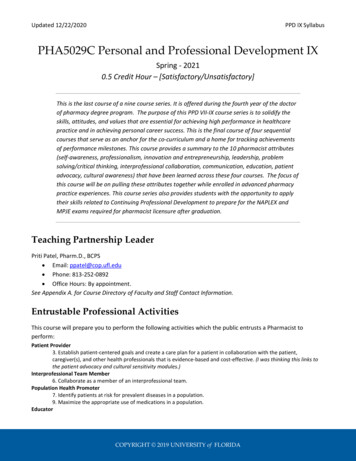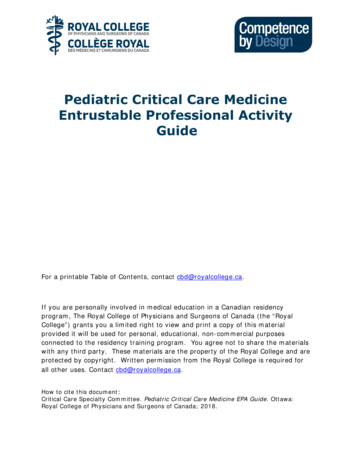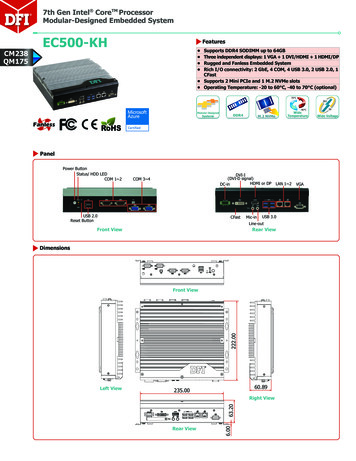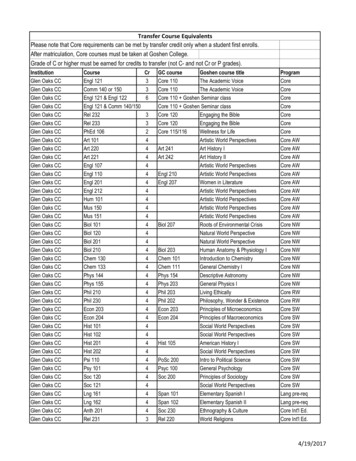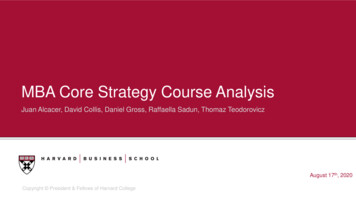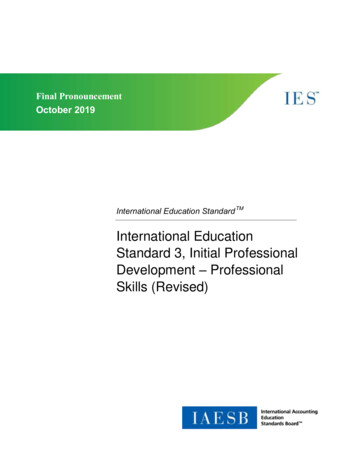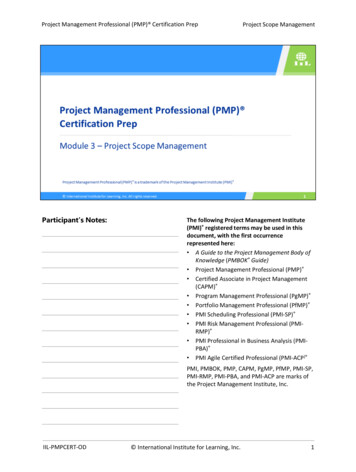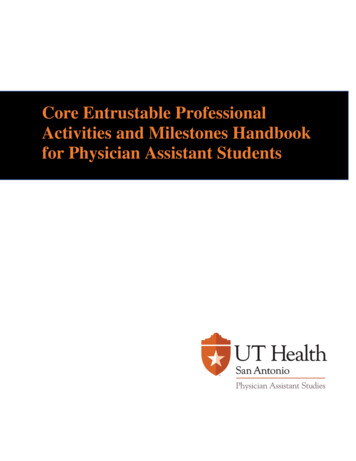
Transcription
Core Entrustable ProfessionalActivities and Milestones Handbookfor Physician Assistant Students
Core Entrustable ProfessionalActivities for Physician Assistant StudentsTable of ContentsBackground and Context for the Entrustable Professional Activities . 5Entrustable Professional Activities, Sub-Competencies and Milestone Framework . 5How Students Use EPAs and Milestones . 7How the PA Program Uses EPAs and Milestones . 8Entrustable Professional Activities (EPAs) . 9EPA 1: Gather essential and accurate info about patients through history taking and physicalexam. 9EPA 2: Prioritize differential diagnoses when given clinical patient information . 10EPA 3: Identify and interpret potential diagnostic and screening tests when given clinicalpatient information . 10EPA 4: Synthesize clinical information to determine appropriate orders and pharmacologicalinterventions . 10EPA 5: Develop and implement patient-centered management and education plans . 10EPA 6: Compose simulated patient documentation to record a clinical encounter. 11EPA 7: Perform a concise and thorough oral presentation of a clinical encounter . 11EPA 8: Locate, critically evaluate, integrate, and appropriately apply scientific evidence topatient care . 11EPA 9: Work and communicate effectively and professionally as a leader or member of aninter-professional health care team to provide patient-centered care . 11EPA 10: Perform general procedures of a physician assistant . 12EPA 11: Identify potential personal weaknesses and/or system failures in order to contribute toa culture of safety and improvement . 12EPA 12: Provide preventive health care services and education . 12Milestones . 13Sub-Competency MK-1: Demonstrates medical knowledge of sufficient breadth and depth topractice as an entry-level physician assistant. . 14UT Health San AntonioDepartment of Physician Assistant Studies2
Core Entrustable ProfessionalActivities for Physician Assistant StudentsSub-Competency MK-2: Demonstrate an investigative and analytic thinking approach toclinical situations. . 15Sub-Competency ICS-1: Create therapeutic and ethically sound relationship with the patientand family members. . 16Sub-Competency ICS-2: Use effective communication skills to elicit and provide information. 17Sub-Competency ICS-3: Work effectively with physicians and other healthcare professionalsas a member or leader of a healthcare team or other professional groups. . 18Sub-Competency ICS-4: Accurately and adequately document information regarding care. . 19Sub-Competency PC-1: Cares for acutely ill patients or injured patient in urgent and emergentsituations and in all settings. . 20Sub-Competency PC-2: Cares for patients with chronic conditions. . 21Sub-Competency PC-3: Partners with the patient, family, and community to improve healththrough disease prevention and health promotion. . 21Sub-Competency PC-4: Performs medical and surgical procedures essential to physicianassistants practicing in this specialty. . 22Sub-Competency PC-5: Use information technology to support patient care decisions andpatient education. . 23Sub-Competency Prof-1: Demonstrates professional conduct and accountability. . 24Sub-Competency Prof-2: Demonstrates humanism and cultural sensitivity. . 25Sub-Competency Prof-3: Maintains emotional, physical and mental health; and pursuescontinual personal and professional growth. . 26Sub-Competency Prof-4: Commitment to ethical principles. . 27Sub-Competency PB-1: Locates, appraises and assimilates evidence from scientific studiesrelated to the patients' health problems. 28Sub-Competency PB-2: Recognizes and appropriately address personal biases, gaps in medicalknowledge, and physical limitations in themselves and others. . 29Sub-Competency PB-3: Analyze practice experience and identify potential practice-basedimprovement activities. . 29Sub-Competency SB-1: Emphasizes patient safety. 30Sub-Competency SB-2: Advocates for effective and efficient healthcare. . 31UT Health San AntonioDepartment of Physician Assistant Studies3
Core Entrustable ProfessionalActivities for Physician Assistant StudentsSub-Competency SB-3: Actively participates in team-based care. . 31Appendix 1 EPAs and Sub-competencies Mapped to Core Competencies of the PA Profession. 32Appendix 2 Competencies of the Physician Assistant Profession . 33Appendix 3 Didactic Learning Outcomes Mapped To EPAs . 36Appendix 4 Clinical Learning Outcomes Mapped To Sub-Competencies . 91References. 206UT Health San AntonioDepartment of Physician Assistant Studies4
Core Entrustable ProfessionalActivities for Physician Assistant StudentsBackground and Context for the Entrustable Professional ActivitiesThe University of Texas Health San Antonio’s Department of Physician Assistant Studiesundertook the process of redefining our curricular progression to realign PA education with themedical model once again. In doing so, we have defined our program’s goals for a newlygraduated PA. Our new graduate PAs must be able to perform, at a minimum, the corecompetencies of the PA profession on a daily basis upon entering into their professional career.To ensure our new graduates can function safely and effectively as a medical clinician we mustbe able to track our student’s trajectory towards competency while in our PA program. To dothis, we adopted the graduate medical model of using Entrustable Professional Activities (EPAs),Sub-Competencies and Milestones.This handbook will explain what EPAs, Sub-Competencies, and Milestones are and how theywill be applied to your education and training while within the University of Texas Health SanAntonio’s Department of Physician Assistant Studies. This handbook is a living documentreflecting the direction of the PA profession. As our profession's agreed upon competencies flexand accommodate new ways to better serve our patient population, our educational supervisionof our students’ proper trajectory will also adjust. In doing so, our EPAs, Sub-Competencies,and Milestones will also flex and accommodate, as appropriate, to meet our goal or graduatingsafe and competent PAs.Entrustable Professional Activities, Sub-Competency and Milestone FrameworkIn order to track the trajectory of acquisition of the general competencies of the Physician, theAmerican Council on Graduate Medical Education (ACGME) launched the Milestones project in2001.1 This effort was in response national public and policymakers concerns about improvingthe graduate medical education of the physician.1 The outgrowth of this project resulted in theACGME milestones project in 2013, which was created to define levels of performanceprogression toward graduate competency for physicians.1 During this effort, the ACGME settledon 6 general competency domains (patient care, medical knowledge, professionalism,interpersonal communication skills, practice-based learning and improvement and systems-basedpractice) based on the general competencies.1 Each medical specialty organization was given thelatitude to create sub-competencies and milestones towards obtaining proficiency in each of the 6general competency areas.1 The sub-competencies, when combined, provide evidence of atrajectory toward the acquisition of competence by physician residents leading to clinicalmedical practice.In order to determine acquisition of the Core Competencies for the Physician AssistantProfession as determined and ratified by the American Academy of Physician Assistants(AAPA), Accreditation Review Commission on Education for the Physician Assistant (ARCPA), National Commission on Certification of Physician Assistants (NCCPA), and the PhysicianAssistant Education Association (PAEA), in 2005 and updated in 2012, we have developed acompetency framework to provide a similar formative assessment of our students. The CoreCompetencies of the Physician Assistant Profession are similar to the general competencies ofthe physician and include the same domains of competence utilized by the ACGME to createmilestones for Physician residencies.2 The uniformity of these competencies provided ourUT Health San AntonioDepartment of Physician Assistant Studies5
Core Entrustable ProfessionalActivities for Physician Assistant Studentsfaculty with the ability to embark on a similar process as the ACGME, utilizing the corecompetencies and sub-competencies to define the trajectory of learning our students need toachieve to progress to practice.We believe that in the Supervised Clinical Practice Experience (SCPE) phase of our program,each PA student’s clinical learning is very similar to that of a medical intern in their first postgraduate year, or a medical resident, in that they are developing and honing knowledge,interpersonal, clinical/technical skills, professional behaviors, clinical reasoning and problemsolving abilities that will allow them to be safe and proficient within their scope of practice.Since most PA programs nationwide graduate generalist PA practitioners, we felt that theMilestones most applicable in scope for analysis were within the medical specialties of FamilyMedicine, Internal Medicine, and General Pediatrics.3 Using the ACGME Milestones and subcompetencies in each respective physician discipline as a guide, we analyzed their relation to ourown Core Competencies of the Physician Assistant Profession and developed Milestones to meetthe scope of practice most appropriate for a physician assistant graduating our program andworking in a primary care discipline.1,2Once developed, these Milestones allowed for insight into the development of specific artifactsof learning and more specific questions for our clinical instructional faculty to provide feedbackon the formative learning of our students. Preceptor evaluation questions were designed to elicitinformation that allows the faculty to determine adherence to the ARC-PA standards ofaccreditation regarding outcomes assessment, acquisition of competency and to identify studentsat risk during the SCPE phase of training earlier, which facilitates the development of effectiveremediation strategies to ensure student success. Milestone acquisition is tracked quarterly foreach student using the same clinical competency committee framework as recommended by theACGME for physicians in residency. During each committee meeting, artifacts of learning andstudent evaluations are analyzed to ensure timely progress toward competency and adherence tothe standards of accreditation throughout the clinical phase of training.In 2014, the Association of American Medical Colleges (AAMC) published the CoreEntrustable Professional Activities for Entering Residency in response to residency programdirectors expressing concern that some medical school graduates were unprepared for residency.4This resulted in an effort to create an integrated list of activities expected of all physiciangraduates moving from Undergraduate Medical Education (UME) to Graduate MedicalEducation (GME) in specialty residencies. The primary motivation for their work as stated waspatient safety.4 By ensuring that students are ready for a clinical clerkship (and safe) through adefined standard, residency directors could be sure that incoming learners had achieved abaseline ability to perform entrustable tasks without supervision.They termed these crucial tasks for practice “Entrustable Professional Activities” (EPA’s) basedthe ACGME definition of EPA, which is “independently executable, observable, and measurablein their process and outcome, and, therefore, suitable for entrustment decisions”.5 The AAMCfelt that medical school EPAs were activities all new medical residents should be expected toperform on day 1 of their residency without direct supervision.4 EPAs were to be observable andquantifiable tasks. .4 They also represent tasks a new resident would be expected to perform on aUT Health San AntonioDepartment of Physician Assistant Studies6
Core Entrustable ProfessionalActivities for Physician Assistant Studentsdaily basis as part of a medical professional’s daily routine. .4 EPAs were developed using thegeneral competencies and milestones as detailed above.We believe that our physician assistant (PA) students transition from didactic-focused learning toclinical-focused learning resembles that of a medical student transition from medical school to amedical residency in many ways. It is because of this similarity that we chose to utilize theAAMC EPAs to inform a process to develop EPAs for our students, which reflected what tasks aPA student entering into their SCPE phase would be expected to be able to perform with minimalsupervision. These EPAs were created using the AAMC’s Core Entrustable ProfessionalActivities for Entering Residency4, the UTHSCSA PA Milestones and the Core Competencies forthe Physician Assistant Profession2 as a guide.Both EPAs and Milestones provide students with tools to use during their educational journey toguide their learning and participate in the educational process. Faculty advising methodologieshave been modified to enable students and faculty to partner with each other to determine thebest method for acquisition of the knowledge, interpersonal, clinical/technical skills, professionalbehaviors, clinical reasoning and problem-solving abilities required to graduate and be successfulas a practicing physician assistant.Our competency framework utilizing EPAs, sub-competencies, and Milestones is in keepingwith the tradition of PA programs utilizing the medical model of competency-based education.The physician profession has provided an excellent example that, with some modification,translates very well to PA education. We feel that this competency framework will continue toensure the students of the University of Texas Health San Antonio’s Department of PhysicianAssistant Studies will be able to obtain the Core Competencies of the Physician AssistantProfession.2 All EPAs and sub-competencies have been visually mapped to the Competencies ofthe Physician Assistant Profession2 to illustrate this (Appendix 1).How Students Use EPAs and MilestonesPA students use EPAs to understand what is expected of them by the time they finish theirdidactic phase of training. Successful demonstration of these EPAs indicates the readiness of thedidactic student to enter the clinical phase of training. The student must progress through theEPAs during their didactic year prior to being allowed to start their clinical rotations. Thisprocess allows for increased student ownership of their own performance. Through preentrustable and entrustable activities, students can assist in planning their own progression. Thestudent will be expected to monitor their progress and seek opportunities for self-improvement inareas that are not progressing as expected. EPA progression and attainment are the primaryresponsibility of the PA student.Milestones are behavioral descriptors indicating levels of performance for given competencies.1,6They represent significant development points along a trajectory during the SCPE phase forphysician assistant students. Milestones are competency-based outcomes reflecting knowledge,skills, attitudes, and performance that are demonstrated progressively by students leading tograduation. 1,6 Through discussions with faculty mentors, students are provided with explicit andclear expectations of performance. Milestones can be used for guided self-assessment andUT Health San AntonioDepartment of Physician Assistant Studies7
Core Entrustable ProfessionalActivities for Physician Assistant Studentsreflection by PA students in preparation for feedback sessions and in creating individual learningplans.1,6Ultimately, PA students should use the Milestones for self-assessment with input and feedbackfrom faculty advisors and mentors only. Students should never judge themselves on theMilestones in isolation.1,6How the PA Program Uses EPAs and MilestonesEPAs and milestones allow the PA Program to monitor the student’s trajectory towardspreparation for clinical learning and ultimately preparation for practice as a licensed physicianassistant. EPAs and milestones are based on competency not time in the PA Program, and thus itis expected that some students will progress more quickly than others. EPA and milestoneprogression are monitored by faculty advisors and the Student Competency Committee. If astudent is not progressing as expected, their individual progress and activities are carefullyexamined. The lack of EPA progression or attainment by a student may indicate to the StudentCompetency Committee or Advisor that additional learning opportunities are required for thestudent or a review by the Student Progress Committee. The establishment of the EPAs andmilestone competency framework will help guide curriculum development and support betterassessment practices, while at the same time enhancing the opportunity to identify strugglingstudents earlier in their training.Milestones enable the movement away from the overreliance on high stakes medical knowledgetesting and use of numeric rating scales on evaluation forms during the clinical phase.1,6 Byconverting performance into a narrative description, they provide a richer context of studentknowledge skills and ability levels achieved during their clinical clerkship and demonstrateacquisition of the competencies of the PA profession. Milestones also facilitate curriculumanalysis by defining the general, essential competencies within the physician assistant discipline.As mentioned above, milestones can be used as a guide to creating more meaningful assessmentsof students during the SCPE phase of training. Gaps in learning can be more easily identified inrelation to the competencies of the profession and provide an opportunity to individualizecoaching, on a by student basis, to assist with progression through the curriculum. 1,6 They alsoestablish a framework for the Clinical Competency Committee during deliberations andjudgments concerning individual student progression. This framework is expected to assist infaculty development, analysis of program outcomes, assist faculty in recognition of performanceexpectations of learners and more explicitly demonstrate the skill progression trajectory of eachstudent.One final note is worth mentioning. EPAs and Milestones are not an all-inclusive representationof the entire curriculum. They are a competency framework to be used as the tools describedabove.1,6UT Health San AntonioDepartment of Physician Assistant Studies8
Core Entrustable ProfessionalActivities for Physician Assistant StudentsEntrustable Professional Activities (EPAs)The University of Texas Health San Antonio’s Department of Physician Assistant Studiescreated the Entrustable Professional Activities found in the sections below. An EntrustableProfessional Activity (EPA) is defined by the ACGME as units of professional practice, definedas tasks or responsibilities that trainees are entrusted to perform unsupervised once they haveattained sufficient specific competence. “EPAs are independently executable, observable, andmeasurable in their process and outcome, and, therefore, suitable for entrustment decisions.”5Much like all medical students entering into residency are expected to have mastered the EPAsprovided in the Core Entrustable Professional Activities for Entering Residency4 handbook, PAstudents entering into their clinical learning year within the University of Texas Health SanAntonio’s Department of Physician Assistant Studies program are expected to have mastered ourEPAs.Our EPAs were created to fit a PA’s scope of practice while ensuring they fulfilled the corecompetencies of the PA profession as outlined in the Core Competencies of the PhysicianAssistant Profession. The Core Competencies of the Physician Assistant Profession weremodified by the addition of numerical references to each core competency to facilitate mappingand can be found in Appendix 2.EPAs were created in an attempt to repackage the Core Competencies of the Physician AssistantProfession in a way that are “independently executable, observable, and measurable in theirprocess and outcome,”5 that fits the scope of physician assistant students graduating from theUniversity of Texas Health San Antonio’s Department of Physician Assistant Studies program.We believe it is crucial that every didactic course and learning outcome is value-added to thecreation of a competent PA student as defined by the Core Competencies of the PhysicianAssistant Profession. To achieve this goal, we successfully mapped all clinical course learningoutcomes to EPAs and EPAs to the Core Competencies of the Physician Assistant Profession.Below you will find the EPAs, and the EPAs mapped to the Core Competencies of the PhysicianAssistant Profession. The mapping of didactic learning outcomes to core-competencies isprovided in Appendix 3.Listed below are the individual EPAs and how they map to the individual Core Competencies ofthe Physician Assistant Profession sub-competencies (represented as numbers below).EPA 1: Gather essential and accurate info about patients through history taking and physicalexamCore Competencies of the Physician Assistant Profession Map:Medical Knowledge 3, 4Interpersonal and Communication Skills 1 – 3Patient Care 2, 3Professionalism 3, 7UT Health San AntonioDepartment of Physician Assistant Studies9
Core Entrustable ProfessionalActivities for Physician Assistant StudentsEPA 2: Prioritize differential diagnoses when given clinical patient informationCore Competencies of the Physician Assistant Profession Map:Medical Knowledge 1 – 5, 9Interpersonal and Communication Skills 2Patient Care 2, 3Professionalism 7Practice Based Learning and Improvement 2EPA 3: Identify and interpret potential diagnostic and screening tests when given clinical patientinformationCore Competencies of the Physician Assistant Profession Map:Medical Knowledge 1 – 5, 8, 9Interpersonal and Communication Skills 4Patient Care 1, 3, 4, 8Professionalism 2Practice Based Learning and Improvement 2, 3EPA 4: Synthesize clinical information to determine appropriate orders and pharmacologicalinterventionsCore Competencies of the Physician Assistant Profession Map:Medical Knowledge 1, 2, 4 – 9Patient Care 3 – 5,Practice Based Learning and Improvement 2EPA 5: Develop and implement patient-centered management and education plansCore Competencies of the Physician Assistant Profession Map:Medical Knowledge 1, 2, 5 – 7Interpersonal and Communication Skills 1, 3, 5Patient Care 2 – 6, 8Professionalism 3, 4, 6, 7UT Health San AntonioDepartment of Physician Assistant Studies10
Core Entrustable ProfessionalActivities for Physician Assistant StudentsEPA 6: Compose simulated patient documentation to record a clinical encounterCore Competencies of the Physician Assistant Profession Map:Medical Knowledge 4 – 9Interpersonal and Communication Skills 2, 6Patient Care 3 – 5Professionalism 1EPA 7: Perform a concise and thorough oral presentation of a clinical encounterCore Competencies of the Physician Assistant Profession Map:Medical Knowledge 1, 3 – 9Interpersonal and Communication Skills 2 – 4Patient Care 1, 3 – 5, 8Professionalism 2, 3EPA 8: Locate, critically evaluate, integrate, and appropriately apply scientific evidence topatient careCore Competencies of the Physician Assistant Profession Map:Medical Knowledge 1 – 3, 5 – 9Interpersonal and Communication Skills 1Patient Care 4, 5, 8, 9Professionalism 4, 5, 8, 9Practice Based Learning and Improvement 2 – 4Systems Based PracticeEPA 9: Work and communicate effectively and professionally as a leader or member of an interprofessional health care team to provide patient-centered careCore Competencies of the Physician Assistant Profession Map:Medical Knowledge 1 – 6Interpersonal and Communication Skills 1 – 6Patient Care 1, 2, 6Professionalism 4, 5, 8, 9Practice Based Learning and Improvement 1Systems Based Practice 1, 3, 5 – 7UT Health San AntonioDepartment of Physician Assistant Studies11
Core Entrustable ProfessionalActivities for Physician Assistant StudentsEPA 10: Perform general procedures of a physician assistantCore Competencies of the Physician Assistant Profession Map:Medical Knowledge 4, 6, 7Patient Care 1EPA 11: Identify potential personal weaknesses and/or system failures in order to contribute to aculture of safety and improvementCore Competencies of the Physician Assistant Profession Map:Interpersonal and Communication Skills 4Professionalism 1, 3 – 5Practice Based Learning and Improvement 1, 5Systems Based Practice 1, 2, 4 – 6, 8EPA 12: Provide preventive health care services and educationCore Competencies of the Physician Assistant Profession Map:Medical Knowledge 7 – 9Interpersonal and Communication Skills 1 – 3Patient Care 2, 4 – 6, 8Professionalism 3Practice Based Learning and Improvement 2Systems Based Practice 9UT Health San AntonioDepartment of Physician Assistant Studies12
Core Entrustable ProfessionalActivities for Physician Assistant StudentsMilestonesThe University of Texas Health San Antonio’s Department of Physician Assistant Studiescreated the clinical sub-competencies and milestones found in the sections below. Our subcompetencies and milestones were adapted from those found within The Family MedicineMilestone Project3, which was created by the ACGME and American Board of Family Medicineto be used within family medicine physician residency programs. Our sub-competencies andmilestones were created to fit a PA’s scope of practice, the amount of time our PA studentsspend in clinically-oriented education, and the organizational design of PA clinical education.The Core Competencies of the Physician Assistant Profession were modified by the addition ofnumerical references to each core competency to facilitate mapping and can be found inAppendix 2.Sub-competencies were created in an attempt to repackage the Core Competencies of thePhysician Assistant Profession with more measurable language that fits the scope of physicianassistant students graduating from the University of Texas Health San Antonio’s Department ofPhysician Assistant Studies program.Milestones provide a step-wise progression for each student to achieve proficiency in the subcompetencies, which we believe demonstrates acquisition of the competencies of the PAprofession.As previously stated, it is crucial that every clinical course and learning outcome is value-addedto the creation of a clinically-competent PA student. To achieve this goal, we successfullymapped all clinical course learning outcomes to our sub-competencies and in turn, mapped thosesub-competencies to the Core Competencies of the Physician Assistant Profession. Below youwill find the sub-competencies, with their associated milestones, and sub-competencies mappedto our professional core competencies. The mapping of clinical learning outcomes to corecompetencies is provided in Appendix 4.Listed below are the individual milestones and
latitude to create sub-competencies and milestones towards obtaining proficiency in each of the 6 general competency areas. 1 The sub-competencies, when combined, provide evidence of a trajectory toward the acquisition of competence by physician residents leading to clinical
